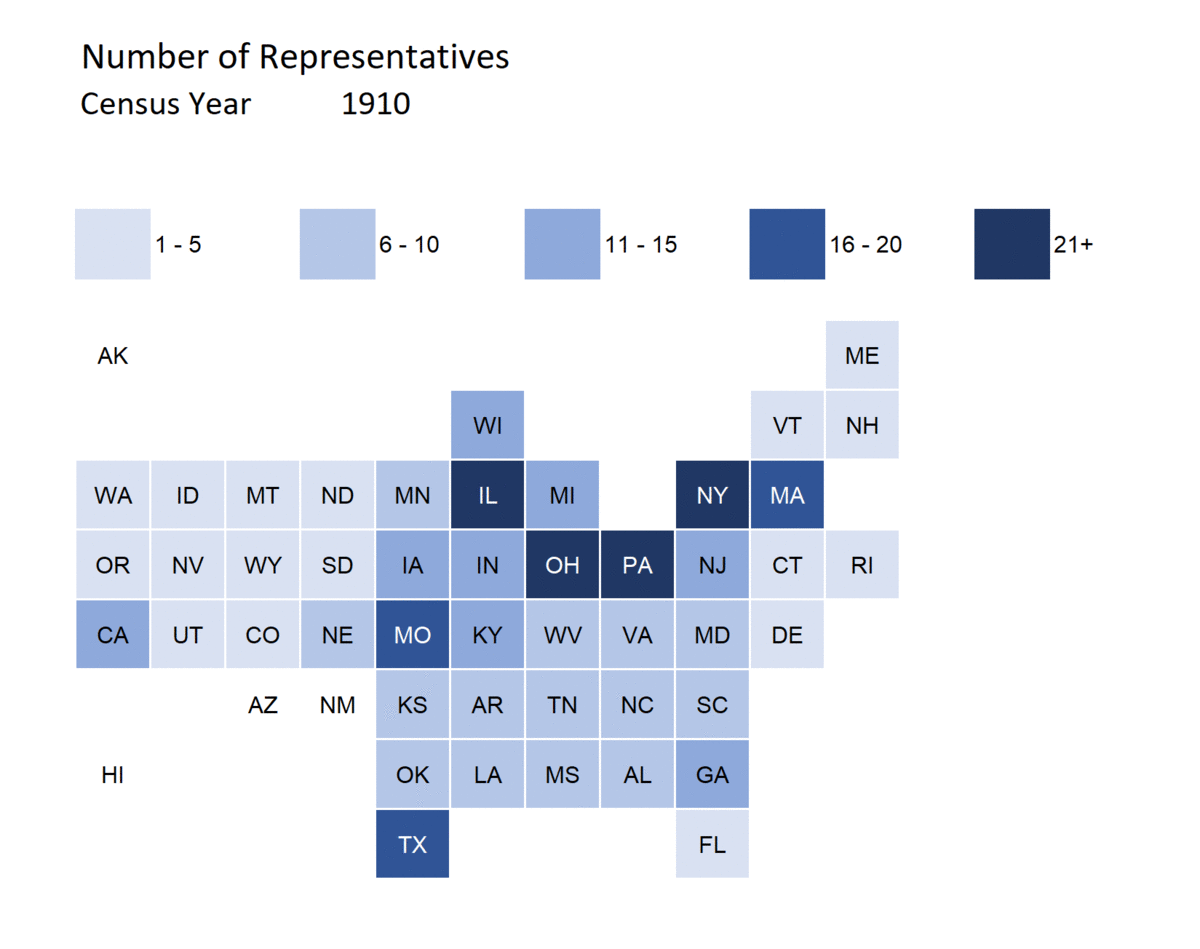Ok, I want to make some visualizations.
There have been 435 seats since the 1910 apportionment. (They should add more, I think)
Give me a moment, and I’m going to have a bit of fun.
Ok, I want to make some visualizations.
There have been 435 seats since the 1910 apportionment. (They should add more, I think)
Give me a moment, and I’m going to have a bit of fun.
First visualization – Sparklines – you can see the shape of the trajectory for different states
For sparklines, each of these have their own vertical axis (min-to-max), but you can see some interesting patterns.
The easy ones are the up-up-up:
California (+41 from 1910-2020)
Texas (+20)
Florida (+24)
Arizona (+8)
Washington (+5)
NC (+4)
Colorado (+4)
Also easy, the down-down-down:
Pennsylvania (-19)
New York (-17)
Illinois (-10)
Missouri (-8)
Ohio (-7)
Massachusetts (-7)
Iowa (-7)
Cool stuff. I understand the vertical axis varying in each Sparkline, I’m curious about the horizontal axis in each graph. Some of those places weren’t states until after 1910 (i.e. AR, AK, HI).
Wow - Iowa being a big loser is kind of surprising. I need to go look up the population of Iowa over the same time period.
Wait, what?
I was expecting them to lose a seat, but they’re not on MPC’s list.
I calculated what they would be based on the 2018 ACS (I think) and Ohio was safe but Rhode Island wasn’t. And CA was really really close, but I can’t recall which way it went. And since AO is gone, so is the thread. ![]()
Which way were you expecting them to go? I don’t think they were close when I checked. They did gain one last time… just barely.
The top 6 states – and their trajectories
Interesting that there are three big winners, and three big losers, but those big losers are still up top
Montana was long predicted to gain a seat. That is the least surprising change to me.
That wasn’t off any sort of study or anything that I did, that was just off my general knowledge of where people are moving and fleeing. I didn’t know Rhode Island was a laggard, it’s small to begin with. Same thing as West Virginia.
Also, to Ranger’s point about Iowa, I was also VERY surprised when I saw old presidential election maps and Iowa’s population. I don’t really know where they lived, given that Iowa had no bigger city than Des Moines. The only thing I could come up with is that Iowa at one time had a LOT more rural population for the time period than it does now.
Crazy that MN kept a seat by 89 respondents/residents.
Did IA have a larger population or a larger relative population?
When I said “for the time period”, I was trying to get at relative population to today. But I don’t really know. I could see either way being true.
Stupid, I just looked at the years in question.
Just larger relative population with fewer states.
For almost all the states losing congressional seats, they grew in population, just much slower than other states. It’s all relative. There have been 435 reps since 1910 (or sometime around then. That’s why I start all my visualizations in 1910.)
I did some visualizations up to 2010 in March:
Have a graphic:

I could update it for 2020, I suppose. Let me see if I can find my spreadsheet.
As I’ve said before, if WY with 580,000 gets one Congressional seat, then every state should get that multiple of seats based on their populations.
Yeah, expand the physical chamber. Gonna need it.
I did a thing
I like this
I have a further idea that the House of Reps would have a revolving geographic location, so that it’s not always in D.C. I think it should be forced to have sessions not only in D.C., but also, let us say, Seattle, Phoenix, Lincoln, Montgomery, Manchester, … and I could generate more places they should be meeting.
If Texas gained two seats, does that mean the Rs gain two seats? Or does the detail show that the D leaning parts of the state grew fast while the R leaning parts were stagnant?
(I don’t think we know yet because the Census hasn’t released detail at that level.)
With 99% certainty, this will mean the Rs gain two seats.
With how gerrymandered that state already is, I would expect another ridiculous looking district that splits up a slightly D district.